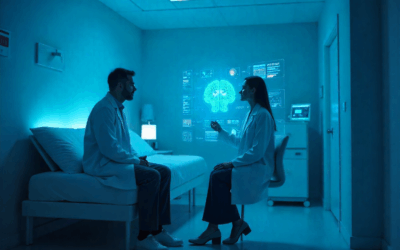The integration of AI-powered medical transcriptions has brought about significant changes in the healthcare sector, reducing the paperwork burden for physicians. AI Medical Scribes assist in creating physician notes more efficiently, allowing healthcare professionals to spend more time focusing on patient care. By minimizing administrative tasks, these innovations promise to alleviate some of the stressors associated with the medical profession.
Mental health issues are a prevalent concern among physicians, with work-related factors such as long hours and emotional demands contributing to elevated stress levels. Research indicates that physicians are at a higher risk of suicide compared to those in other professions. For instance, recent data suggests that physician suicide rates in the USA are notably higher than the general population. Similar patterns emerge in Canada, while South African data highlights the global relevance of this mental health crisis in the medical field. Reducing the paperwork and enhancing efficiency with AI-powered Medical Scribes could significantly lower these risks by alleviating some of the everyday pressures physicians face.
AI Medical Scribes can play a crucial role in improving mental well-being among physicians by streamlining workflow and reducing burnout. Providing accurate, real-time transcriptions allows doctors to reclaim valuable time, reducing the emotional and physical toll associated with excessive documentation. The adoption of such technologies in regions like Canada, the USA, and South Africa can lead to improved mental health outcomes for those within the medical community, directly addressing the rising suicide risk among healthcare professionals.
UNDERSTANDING AI MEDICAL SCRIBES
AI medical scribes utilize natural language processing and complex algorithms to assist in creating accurate clinical notes. These tools work alongside physicians to transcribe patient interactions directly into an electronic health record (EHR), reducing manual paperwork. Automatic speech recognition (ASR) technology is often employed to transcribe spoken language in real time, which helps streamline the documentation process and improve efficiency. The primary aim is to reduce administrative burdens on healthcare professionals.
IMPACT ON CLINICAL DOCUMENTATION EFFICIENCY
AI-powered medical transcriptions significantly increase the efficiency of EHR workflows. Physicians can focus more on direct patient care by minimizing the time spent on documentation. This reduction in clerical tasks addresses one of the key factors contributing to physician burnout, potentially reducing the risk of suicide in this profession. Enhanced accuracy and consistency in transcriptions ensure that critical patient data is captured effectively, further alleviating stress. The automated system also enhances data organization, facilitating better clinical decisions.
In Canada, AI medical scribes are integrated to ease EHR documentation in primary care settings. The USA sees widespread adoption across various specialties, focusing on reducing clinician workload and improving patient engagement. In a country like South Africa, the healthcare sector is catching up with pilot programs that use AI scribes to optimize clinical efficiency. Each country experiences different levels of implementation, influenced by technological infrastructure and healthcare policy priorities. Collaboration between tech firms and healthcare organizations drives this integration, potentially leading to more widespread adoption in the future.
THE MENTAL HEALTH CHALLENGES FACING PHYSICIANS
Mental health challenges are significantly prevalent among physicians, impacting their well-being and increasing their risk of suicide when compared to the general population. Understanding the prevalence, associated suicide rates, and work-related factors contributing to this risk is critical.
PREVALENCE OF MENTAL HEALTH ISSUES IN PHYSICIANS
Physicians often experience high levels of stress, which contributes to mental health issues such as depression and anxiety. The prevalence of mental illness in this profession exceeds that of many other sectors, with a notable proportion of doctors reporting symptoms of burnout. Factors like extended work hours, high patient loads, and the emotional toll of patient care exacerbate these issues.
An alarming portion of healthcare professionals struggle with recognizing or admitting mental health issues due to fear of stigmatization, which can lead to underreporting and an untreated condition. Encouraging open dialogue on mental health amongst colleagues can help address these challenges within the healthcare community.
THE RISING MENTAL HEALTH CRISIS IN THE MEDICAL FIELD
Suicide rates among physicians are notably higher than in the general population. Male physicians have a suicide rate 1.4 times higher, and female physicians 2.3 times higher than the general population. This stark reality reflects the intense pressures and responsibilities faced by medical professionals. Studies indicate these rates remain consistent over time, necessitating enduring preventative strategies.
Comparison to other professions highlights the urgent need for targeted interventions. Suicide prevention strategies, tailored specifically for healthcare settings, can help mitigate these risks by fostering healthier work environments and providing accessible mental health support services for beleaguered physicians.
WORK-RELATED FACTORS CONTRIBUTING TO BURNOUT RISK
Multiple work-related factors contribute to the elevated suicide risk among physicians. These include long hours, excessive administrative duties, and the emotional strain of dealing with patient suffering and death. The risk factors are compounded by inadequate support systems and the stigma surrounding mental health within the medical community.
Efforts to alleviate these work-related pressures involve reducing non-clinical tasks and fostering an environment where mental health is prioritized. Training programs focusing on suicide risk assessment and mental health care can empower medical staff to manage stress better and seek help when needed, potentially reducing the suicide risk in this vulnerable population.
COMPARATIVE RISKS IN DIFFERENT PROFESSIONS
Suicide among professionals, especially physicians, is a significant public health issue. Various factors, including work stress and mental health challenges, contribute to higher risks compared to other professions.
STATISTICAL DATA ON PHYSICIAN BURNOUT
Physicians face a higher risk of suicide compared to the general population. Epidemiological data indicates that the suicide rate among physicians is more than twice that of the general population. Stigma and access to means are contributing factors.
In the United States, estimates suggest that around 300 to 400 physicians die by suicide each year, with rates among female physicians notably higher than their male counterparts when adjusted for the general population.
CORRELATION BETWEEN PROFESSION AND MENTAL HEALTH RISKS
Comparing professions, physicians exhibit higher suicide risks attributed to occupational stressors and mental health burdens. Professions such as dentistry and law also show elevated risks; however, the unique demands and responsibilities in medical fields amplify the risk factors.
Factors such as burnout, long working hours, and emotional toll contribute to suicidal behavior. Public health initiatives focus on suicide prediction and risk assessment to address these disparities. The cost of suicide in healthcare professions extends beyond personal loss, impacting colleagues’ mental health and healthcare service delivery.
THE ROLE OF AI IN BURNOUT RISK REDUCTION
Artificial intelligence is playing a pivotal role in reducing suicide risk among physicians. By utilizing AI-powered tools for mental health assessment and suicide prediction, healthcare systems can leverage technology to improve outcomes for healthcare professionals facing burnout and mental health challenges.
UTILIZING AI FOR BETTER MENTAL HEALTH OUTCOMES
AI algorithms can analyze large datasets to identify patterns associated with mental health issues. These tools can process input from electronic health records and wearable devices to provide insights into stress levels.
By monitoring these variables, AI can assist healthcare providers in recognizing early signs of distress, leading to timely interventions. This proactive approach can reduce the mental burden on physicians and afford them the support they need.
AI IN PREDICTING AND PREVENTING PHYSICIAN BURNOUT
AI-driven suicide prediction models, such as neural networks, are being used to assess suicide risk factors among healthcare professionals. These models can integrate data from various sources, including clinical risk assessments, to gauge the likelihood of suicidal thoughts or actions in physicians.
Such predictive tools allow hospitals and medical practices to design targeted intervention strategies. By addressing these risks early, healthcare systems can tailor support systems to the needs of vulnerable physicians, potentially reducing the incidences of burnout.
THE FUTURE OF AI SCRIBES IN HEALTHCARE
AI medical scribes facilitate the creation of physician notes with minimal paperwork, enabling doctors to focus more on patient care and less on administrative tasks. This reduction in workload can lead to decreased stress levels among physicians.
By providing real-time transcriptions and streamlining workflow processes, AI scribes contribute to a better work-life balance for doctors. As AI technology continues to evolve, its integration into healthcare settings could enhance both the efficacy of mental health support and the overall well-being of medical professionals.




